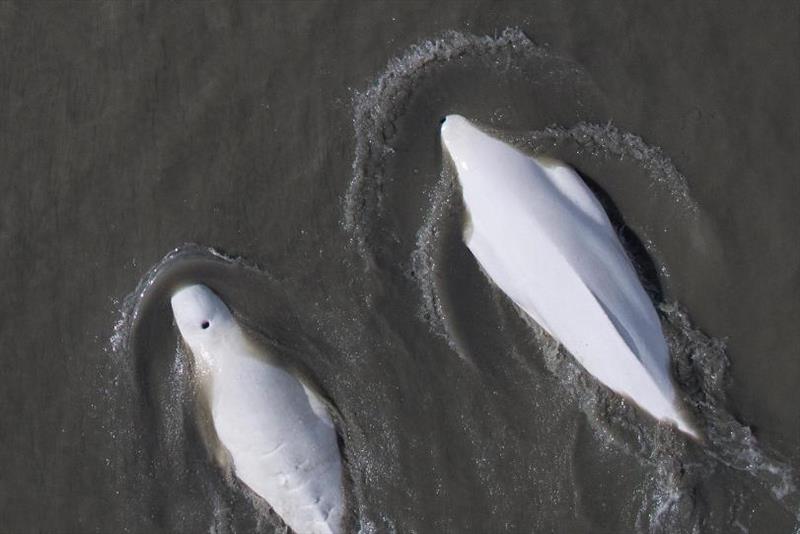
New genetic study makes it possible to accurately estimate age of endangered whales while alive
by NOAA Fisheries 14 Feb 2021 17:28 UTC

Beluga whales in Cook Inlet, Alaska © NOAA Fisheries
Newly published research allows marine biologists to determine the age of beluga whales with a small skin sample. The new epigenetic methodology could revolutionize the way scientists study endangered Cook Inlet beluga whales and provide valuable insights into why the population may not be recovering.
NOAA Fisheries researchers participated in the collaborative study with scientists at Oregon State University and University of California Las Angeles. Epigenetics is the study of how behaviors and environment can cause changes that affect the way genes work.
In cetaceans, age is critically important but often unknown due to the difficulty of determining age in long-lived, mobile species.
"Up until now, our ability to determine the age of beluga whales was opportunistic. We had to rely on getting tooth samples from either stranded, dead whales or those harvested by subsistence hunters. We would then count annual growth-layer groups in each tooth to estimate the whale's age. We were also able to get some idea of beluga whale age by its skin color. When belugas are born they are dark grey. Over time, their skin color gets lighter until they are white," said Paul Wade, marine mammal biologist, Alaska Fisheries Science Center and co-author of the new study. "Now, with just a small sample of skin from an animal when it's alive, we will be able to learn about the animal's age, sex, and much more."
Partnership aids in ageing beluga whales
From 2016 to 2018, Wade and fellow researchers collected skin samples from whales in Cook Inlet during annual boat studies with the population. Wade then worked with colleagues C. Scott Baker and Eleanor (Ellie) Bors at Oregon State University to develop a new epigenetic tool for determining the age of beluga whales.
Genetics predominantly focuses on DNA itself. Epigenetics is the study of the ways in which DNA is modified or packaged within a cell that affect how it is used, or expressed. For this study, the researchers focused on one specific modification of DNA called methylation.
Methylation is a mechanism that turns biological switches on and off for a host of systems in a mammal's body, changing the way genes function. It is an important component in numerous cellular processes, including embryonic development, genomic imprinting, and X-chromosome inactivation. Errors in methylation have been linked to several human diseases. In this case, understanding methylation in beluga whales was key to determining the age of individual animals and to learning more about their sex and reproductive state.
Bors, the lead author of the new paper, analyzed DNA methylation data from 67 whales that had paired samples of skin and teeth. Data were collected from stranded whales that died between 1992 and 2015 and were archived by NOAA at the Southwest Fisheries Science Center. The ages of the whales had been determined by the traditional method of counting tooth growth-layer groups.
Kim Shelden, Alaska Fisheries Science Center, organized this calibration data set that Bors used for comparing observed relationships to estimates produced using computer models.
To collect the epigenetic data, Bors used a technology developed by Steve Horvath at UCLA to study epigenetic aging in diverse mammal species, including humans. Bors then used these data to create a model, or "epigenetic clock," that predicts the age of a beluga whale based on methylation levels at just 23 locations in its genome. Bors used the model to analyze 38 collected biological samples from living whales, supplied by Wade, to predict their ages. Using the ages provided by the beluga epigenetic clock, Wade was able to better understand reproductive state in beluga whales.
This is one of the first applications of new epigenetic methods to a living population of endangered whales.
The Cook Inlet beluga whales are one of nine NOAA Fisheries "Species in the Spotlight," among the most at risk of extinction in the near future. The population of Cook Inlet belugas declined rapidly in the 1990s, most likely because of unregulated hunting at a level that this small population could not sustain. It shows no signs of recovery. They were listed as an endangered species under the Endangered Species Act in 2008.
Future research directions
According to Wade, the ability to estimate the age of living whales opens the door to new research that may help explain the lack of recovery of this population. The key to unlocking this puzzle will be in understanding if the decline is driven by a lack of reproduction or an increase in mortality. The biopsy samples are also used for many other analyses. For instance, Nick Keller, Southwest Fisheries Science Center, has conducted some preliminary analyses of hormones to estimate progesterone levels in the blubber of female whales to identify which are pregnant.
Although the sample sizes are small, this initial data set indicates only one whale under the age of 19 was pregnant, whereas half the whales 19 or older were.
According to Wade, this is a somewhat surprising result given that previous publications have estimated the age of first reproduction of beluga whales to be approximately 8-10 years. In addition, populations below carrying capacity with abundant prey usually reproduce at younger ages rather than delaying. If Cook Inlet beluga whales are not commonly reproducing until they are older, this could be hindering the ability of the population to recover. However, further analysis is needed comparing the Photo-ID record with genetic results to learn more about the reproductive histories of sampled whales.
"Some of these females may have been photographed with a calf the year they were sampled or in years prior. Unless the sampling occurred close to the time the birth occurred, we wouldn't really expect the progesterone levels to remain sufficiently high to be designated as a pregnancy," he said.
This research was made possible with support from the North Pacific Research Board.